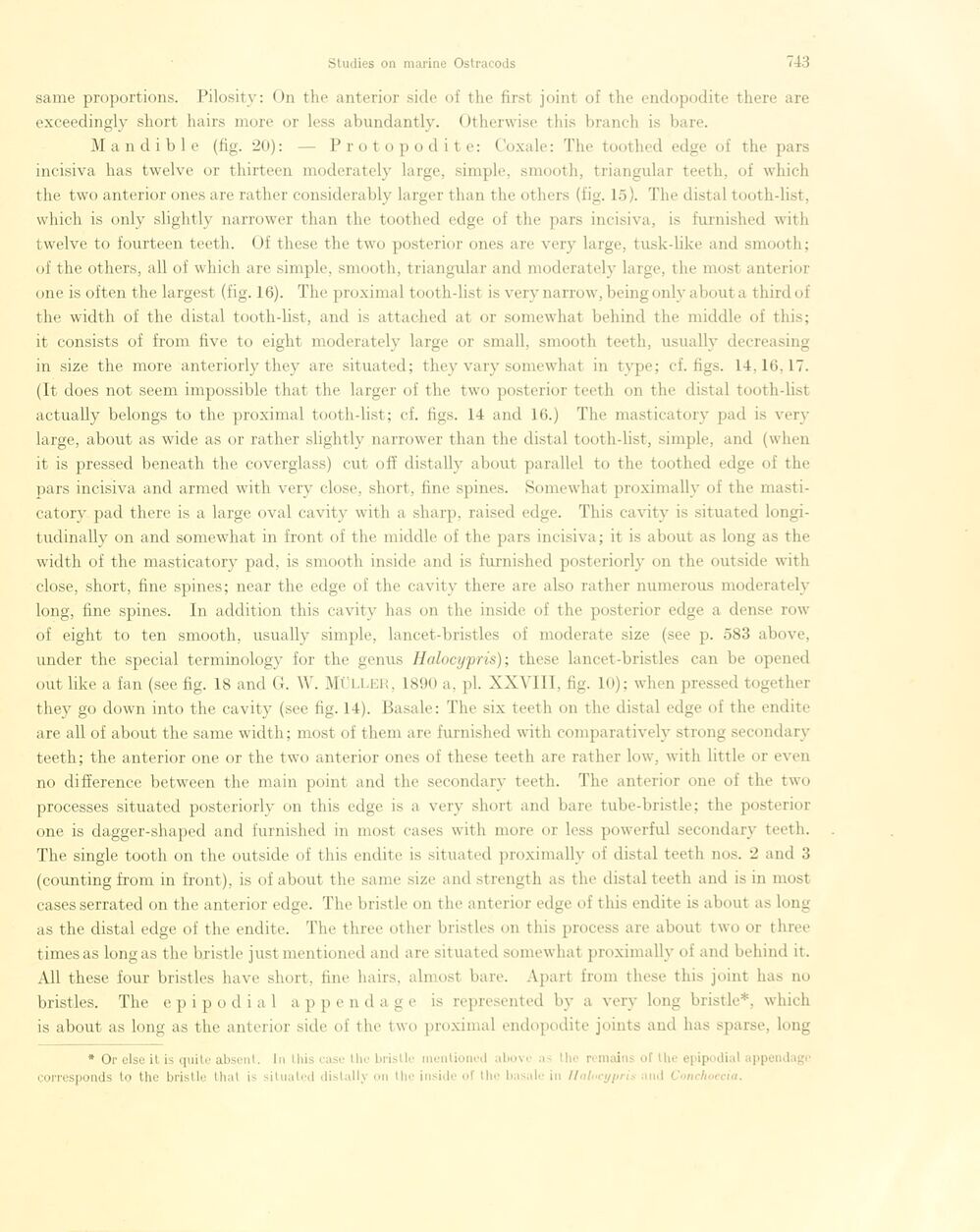
Full resolution (JPEG) - On this page / på denna sida - Sidor ...

<< prev. page << föreg. sida << >> nästa sida >> next page >>
Below is the raw OCR text
from the above scanned image.
Do you see an error? Proofread the page now!
Här nedan syns maskintolkade texten från faksimilbilden ovan.
Ser du något fel? Korrekturläs sidan nu!
This page has never been proofread. / Denna sida har aldrig korrekturlästs.
same proportions. Pilosity: On the anterior side of the first joint of the endopodite there are
exceedingly short hairs more or less abundantly. Otherwise this branch is bare.
Mandible (fig. 20) : — Protopodite: Coxale : The toothed edge of the pars
incisiva has twelve or thirteen moderately large, simple, smooth, triangulär teeth, of whieh
the two anterior ones are rather considerably larger than the others (fig. 15). The distal tooth-list,
which is only slightly narrower than the toothed edge of the pars incisiva, is fumished with
twelve to fourteen teeth. Of these the two posterior ones are very large, tusk-like and smooth;
of the others, all of which are simple, smooth, triangulär and moderately large, the most anterior
one is often the largest (fig. 16). The proximal tooth-list is very narrow, being only about a third of
the width of the distal tooth-list, and is attached at or somewhat behind the middle of this;
it consists of from five to eight moderately large or small, smooth teeth, usually deereasing
in size the more anteriorly they are situated; they vary somewhat in type; cf. figs. 14,16,17.
(It does not seem impossible that the larger of the two posterior teeth on the distal tooth-list
actually belongs to the proximal tooth-list; cf. figs. 14 and 16.) The masticatory pad is very
large, about as wide as or rather slightly narrower than the distal tooth-list, simple, and (when
it is pressed beneath the eoverglass) cut off distally about parallel to the toothed edge of the
pars incisiva and armed with very close, short, fine spines. Somewhat proximally of the
masticatory pad there is a large oval cavity with a sharp, raised edge. This cavity is situated longi
-tudinally on and somewhat in front of the middle of the pars incisiva ; it is about as long as the
width of the masticatory pad, is smooth inside and is furnished posteriorly on the outside with
close, short, fine spines; near the edge of the cavity there are also rather numerous moderately
long, fine spines. In addition this cavity has on the inside of the posterior edge a dense row
of eight to ten smooth, usually simple, lancet-bristles of moderate size (see p. 583 above,
under the special tcrminology for the genus Ilalocypris); these lancet-bristles can be opened
out like a fan (see fig. 18 and G. W. MÜLLER, 1890 a, pl. XXVIII, fig. 10); when pressed together
they go down into the cavity (see fig. 14). Basale: The six teeth on the distal edge of the endite
are all of about the same width; most of them are furnished with comparatively strong secondary
teeth; the anterior one or the two anterior ones of these teeth are rather low, with little or even
no difference between the main point and the secondary teeth. The anterior one of the two
processes situated posteriorly on this edge is a very short and bare tube-bristle; the posterior
one is dagger-shaped and furnished in most cases with more or less powerful secondary teeth.
The single tooth on the outside of this endite is situated proximally of distal teeth nos. 2 and 3
(counting from in front), is of about the same size and strength as the distal teeth and is in most
cases serrated on the anterior edge. The bristle on the anterior edge of this endite is about as long
as the distal edge of the endite. The three other bristles on this process are about two or three
times as longas the bristle just mentioned and are situated somewhat proximally of and behind it.
All these four bristles have short, fine hairs, almost bare. Apart from these this joint has no
bristles. The e p i p o d i a 1 appendage is represented by a very long bristle*, which
is about as long as the anterior side of the two proximal endopodite joints and has sparse, long
* Or olse il is quito absent. In Ibis rase lhe brislle mentioned abow a- the remains of the epipodial appendage
corresponds to the brislle that is situated distally on the inside of the basale in llnluci/iiris and Conchnecia.
<< prev. page << föreg. sida << >> nästa sida >> next page >>